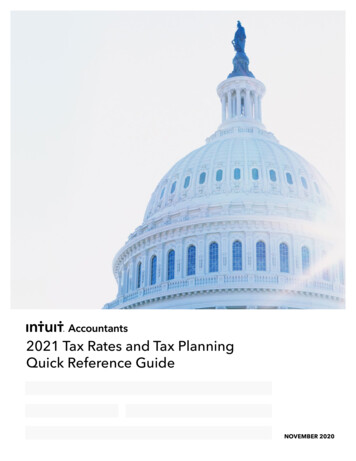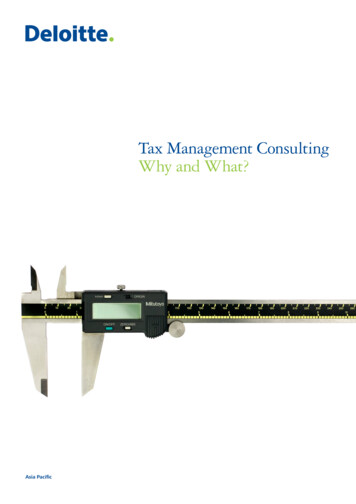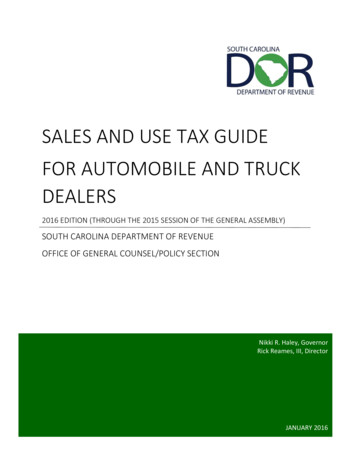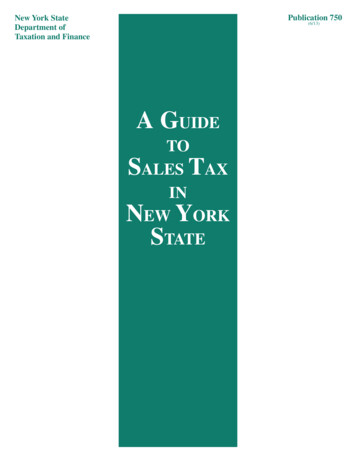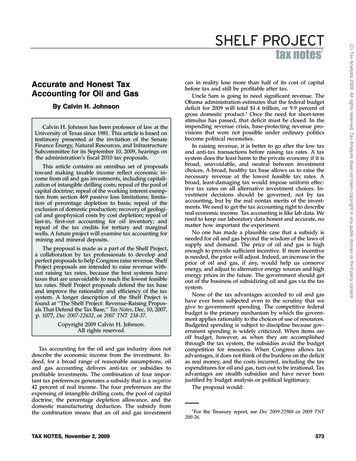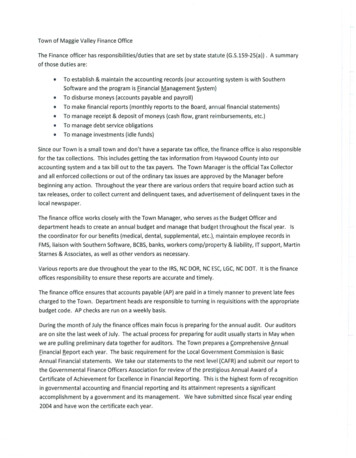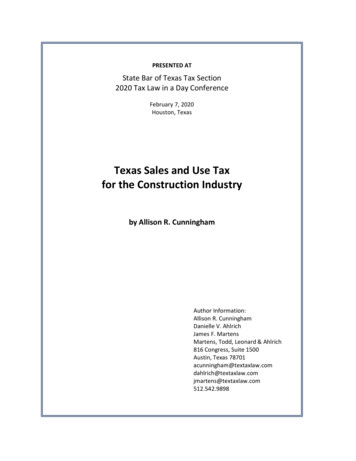
Transcription
PRESENTED ATState Bar of Texas Tax Section2020 Tax Law in a Day ConferenceFebruary 7, 2020Houston, TexasTexas Sales and Use Taxfor the Construction Industryby Allison R. CunninghamAuthor Information:Allison R. CunninghamDanielle V. AhlrichJames F. MartensMartens, Todd, Leonard & Ahlrich816 Congress, Suite 1500Austin, Texas omjmartens@textaxlaw.com512.542.9898
Allison R. Cunningham, JDMs. Cunningham is a Texas tax litigation attorney with Martens, Todd,Leonard & Ahlrich, a boutique tax litigation law firm located in Austin.She and other members of her firm limit their law practices to Texassales and use tax and Texas franchise tax controversies and litigation.Ms. Cunningham is licensed by the State Bar of Texas and representsTexas tax taxpayers before the State Office of Administrative Hearingsand all state trial and appellate courts. Ms. Cunningham writes andspeaks on a variety of Texas tax subjects, including the Texas sales &use and franchise taxes.Ms. Cunningham holds a bachelor’s degree from the University of Texas at Austin and a JurisDoctorate from the University of Texas School of Law.Contact InformationMartens, Todd, Leonard & Ahlrich816 Congress AvenueSuite 1500Austin, TX 78701512-542-9898acunningham@textaxlaw.com
Table of ContentsI.Introduction . 1II. Texas Sales and Use Tax Principles Applicable to the Construction Industry . 1a.Sales Tax Versus Use Tax . 2b.Taxable Items in the Construction Context . 3c.Properly Identifying Property Types . 5d.i.Real Versus Tangible Property . 5ii.Residential Versus Commercial Property . 6The Most Commonly Applicable Exemption: Sale for Resale . 7III. Contract Pricing . 8a.Lump-sum v. Separated . 8b.Reimbursements . 10IV. Common Pitfalls to Avoid . 11a.The Mixed Services Rule . 11b.Assessments Arising from Tax Collected in Error . 12c.Failure to Modify Standard Contracts. 13i.Tax-Included Contracts . 13ii.Incorporation of Documents that Impact Contract Pricing . 15V. Conclusion . 16VI. Appendicesa.The Comptroller’s Tax Policy News: Contractors and Related Services – Part 1 (Aug.2018b.The Comptroller’s Tax Policy News: Contractors and Related Services – Part 2 (Sept.2018)c.The Comptroller’s Tax Policy News: Contractors and Related Services – Part 3 (Oct.2018)d.The Comptroller’s Tax Policy News: Contractors and Related Services – Part 4 (Dec.2018)e.The Comptroller’s Tax Policy News: Reimbursements for Contractors and TaxableService Providers (Nov. 2019)
I.IntroductionProper handling of Texas sales and use tax obligations is crucial to preserving profitmargins and avoiding audit headaches within the construction industry. This paper addresses themost commonly taxable items in construction projects and how contract pricing dictates when andfrom whom Texas sales and use tax is due. Understanding contract pricing is key to minimizingadverse audit assessments, so awareness of variances between industry and Comptroller usage ofcommon terms—like lump-sum and separated contracts—is essential. This paper then concludeswith a discussion of common pitfalls that generate Texas sales and use tax audit assessments,including mistreatment of sales tax between the bid and contract phases, over-reliance onstandardized industry forms that do not adequately address Texas sales and use tax matters, andincorporation of documents into a construction contract that impacts contract pricing.II.Texas Sales and Use Tax Principles Applicable to the Construction IndustryAlthough several Texas taxes apply to the construction industry, this paper limits itsdiscussion to Texas sales and use tax. Texas Tax Code Chapter 151 imposes sales and use tax onthe sale, lease or rental of tangible personal property and on certain specified services. 1 Tangiblepersonal property is property that is touchable or moveable, and does not include real property. 2Texas’ sales and use taxes are complementary, meaning that they do not overlap, but, rather, areintended to uniformly tax transactions once, whether the taxable transaction is consummated in oroutside of Texas. 3 The state sales and use tax rate is 6.25%, although various local jurisdictions1See TEX. TAX CODE ANN. §§ 151.001–.801 (West 2015).2See TEX. TAX CODE ANN. § 151.009 (West 2015).Combs v. Chapal Zenray, Inc., 357 S.W.3d 751, 757 (Tex. App.—Austin 2011, pet. denied) (“The use taxcomplements the state sales tax and is designed to tax transactions not reached by the sales tax. The use tax thusapplies to use or consumption in this state of property purchased outside the state. The purpose of the use tax is ‘tomore evenly distribute the tax burden among all consumers by imposing a tax on the fruits of an interstate purchaseas well as on the sale of property in this State.’ The use tax serves to prevent ‘avoidance of a state's sales tax by the31
may impose up to an additional 2% in local sales and use taxes. 4 The maximum possible tax rateis 8.25%.a.Sales Tax Versus Use TaxTexas imposes sales tax on sales of taxable items in Texas. 5 Thus, for example, if aconstruction company located in San Antonio purchases a diesel-powered backhoe from a supplierlocated in Houston, the construction company must pay sales tax on this purchase because thetransaction is consummated in Texas.In contrast, Texas imposes use tax when items are acquired out-of-state and brought intoTexas for storage, use, or consumption. 6 Without the use tax, persons could purchase items froman out-of-state retailer, use the items in Texas, and escape paying tax. 7 The use tax prevents thisabuse and places out-of-state vendors on an even playing field with Texas vendors because itremoves a purchaser’s incentive to shop outside of Texas to save on tax. 8 Thus, if the same SanAntonio construction company purchased a backhoe from a supplier located in Tulsa, Oklahoma,the construction company would owe Texas use tax on its purchase and must accrue and remit theTexas use tax to the Texas Comptroller. If sales tax was legally-owed and paid in Oklahoma, theconstruction company would be entitled to a tax credit for the Oklahoma sales tax paid against theTexas use tax due.purchase of goods in another state, and to place retailers in the state upon equal footing with out-of-statecompetitors, who are not obligated to collect and remit sales tax.’ In accordance with the complementary nature ofthe use and sales taxes, use tax is not applicable to a purchaser who has paid sales tax to a Texas retailer . . . and anyexemption applicable to the sales tax applies to the use tax.”) (internal citations omitted).4TEX. TAX CODE ANN. §§ 151.051(b), .101(b) (West 2015); 34 Tex. Admin. Code § 3.334(a)(22) (2015).5TEX. TAX CODE ANN. § 151.051(a) (West 2015).6Id.7Combs v. Chapal Zenray, Inc., 357 S.W.3d 751, 757 (Tex. App.—Austin 2011, pet. denied).8Id.2
b.Taxable Items in the Construction ContextAs relevant to Texas sales and use tax, construction services include all forms of realproperty work, such as real property improvements; new construction; and repair, remodeling,restoration, and maintenance of both residential and non-residential properties. Constructioncompanies’ services and purchases may be subject to Texas sales and use tax. This paper limitsits scope to the most common taxable items (tangible personal property and certain enumeratedservices) in the construction context, which include: Materials Incorporated into Real Estate.Sales of tangible personal property aretaxable. 9 For example, if a contractor purchases roofing material in Texas for a Texasproject, the purchase is subject to the Texas sales tax. Supplies Consumed at the Construction Site. Sales of supplies to be consumed in thecourse of operating a business or while providing services (taxable or non-taxable) aretaxable. 10 For example, if a contractor purchases paint drop cloths in Texas for use atTexas projects, the purchase is subject to Texas sales tax. Equipment Used to Provide Services. Purchases of equipment and tools used to provideservices (taxable or non-taxable) are taxable. 11 For example, if a contractor purchases ahammer in Texas to construct foundation forms at a Texas job site, the purchase is subjectto Texas sales tax.9TEX. TAX CODE ANN. §§ 151.009, .010, .051 (West 2015).10Id.11Id.3
Leased Equipment (With and Without Operators). Leases are taxable when theunderlying property, if purchased outright, would be subject to Texas sales and use tax. 12For example, a contractor owes Texas sales tax on the monthly lease payments for agenerator used to power field lighting on a Texas project. However, when taxable items,like equipment, are leased with an operator, the application of the Texas sales and use taxrules become more complex because this transaction is presumed to be the performance ofa service. A service is only taxable if it falls within the finite list of services stated in TexasTax Code Section 151.0101. Real Property Services. Charges for certain types of real property services—such assurveying, grounds cleaning, weed control, and pest control—are taxable. 13 For example,if a contractor purchases surveying services to determine Texas site boundaries, thepurchase of this service is subject to Texas sales tax. Non-residential (Commercial) Real Property Repairs and Remodeling. Charges torepair or remodel non-residential (commercial) real property are taxable. 14 For example,charges to remodel a Texas office building are subject to Texas sales tax. Tangible Personal Property Repairs and Remodeling. Charges to repair or remodelmost tangible personal property are taxable. 15 For example, charges to repair constructionequipment are subject to Texas sales tax.12TEX. TAX CODE ANN. §§ 151.005, .051 (West 2015).13TEX. TAX CODE ANN. §§ 151.0101(a)(11), .0048 (West 2015).14TEX. TAX CODE ANN. §§ 151.0101(a)(13), .0047 (West 2015).15TEX. TAX CODE ANN. §§ 151.0101(a)(5) (West 2015).4
Notably, the above list of common taxable items does not include labor charges for newconstruction or residential repairs and remodeling.The Comptroller, by rule, defines newconstruction as “all new improvements to real property, including initial finish-out work to theinterior or exterior of the improvement.” 16 New construction also includes the addition of new,usable square footage to an existing structure. 17 For example, adding a second floor to a one-storybuilding without raising the roof of the first floor is new construction. 18 Whether constructionwork constitutes new construction is only relevant for work performed on non-residential(commercial) structures because labor charges for residential work are not taxable, whether thework is performed on new or existing structures.c. Properly Identifying Property TypesAs demonstrated by the above list of taxable items, to properly handle their Texas salesand use tax obligations, contractors must be able to distinguish tangible personal property fromreal property, and residential real property from commercial real property.i. Real Versus Tangible PropertyTexas law defines real property as land, including structures and other improvementsembedded in or permanently affixed to the land. 19 Case law sets forth a three-factor test todistinguish real from tangible personal property: the mode and sufficiency of the annexation torealty, either real or constructive; the adaptation of the item to the use or purpose of the realty; andthe intent of the party who annexed the personal property to the realty. 20 Comptroller auditors are1634 TEX. ADMIN. CODE §§ 3.291(a)(9), 3.357(a)(8) (2002).17See 34 TEX. ADMIN. CODE §§ 3.291(a)(9), 3.357(a)(8) (2002).18See 34 TEX. ADMIN. CODE § 3.357(a)(8) (2002)19Logan v. Mullis, 686 S.W.2d 605, 607 (Tex. 1985); 34 TEX. ADMIN. CODE § 3.357(a)(10) (2002).20Logan v. Mullis, 686 S.W.2d 605, 607 (Tex. 1985); Hutchins v. Masterson & Street, 46 Tex. 551 (1887).5
trained to determine the parties’ intent by reviewing contracts, authorizations for expenditures,annual reports, and other documentation. 21The following example illustrates the distinction between real and tangible personalproperty. If a property owner purchases a hot tub and installs it in a portable gazebo in hisbackyard, the portable nature of the gazebo may indicate an intent that the hot tub will be movedwhen the owner sells the house and, thus, support a characterization of the hot tub as tangiblepersonal property. In contrast, if the property owner installs the hot tub in his bathroom duringremodeling construction, the hot tub would most likely be characterized as real property due to thedamage removal would cause (e.g., tearing out one of the new walls).ii. Residential Versus Commercial PropertyThe sales and use tax laws also require contractors to distinguish between residential andnon-residential (commercial) real property. Residential real property is defined as property that isused as a family dwelling, multifamily apartment or housing complex, nursing home,condominium, or retirement home. 22 The term includes homeowners-association-owned andapartment-owned swimming pools, laundry rooms, and other common areas designated fortenants' use. 23 Everything else is non-residential real property. 24 Examples include: hotels,motels, hospitals, prisons, rehabilitation centers, and recreational vehicle parks. 25 UnderstandingTEXAS COMPTROLLER OF PUBLIC ACCOUNTS, AUDIT PROCEDURES FOR CONTRACTORS & REPAIRMEN, 1 (April2017), available at tractor-manual.pdf.212234 TEX. ADMIN. CODE §§ 3.291(a)(12); 3.357(a)(13) (2002).23Id.TEXAS COMPTROLLER OF PUBLIC ACCOUNTS, Pub. No. 94-157, HOMEBUILDERS AND REAL PROPERTY SERVICES(Mar. 1, 2001), available at 4-157.php.2425Id.6
the distinctions between residential and non-residential property is important because the chargefor any type of residential construction labor (new construction or repair and remodeling) is nottaxable.d.The Most Commonly Applicable Exemption: Sale for ResaleA variety of Texas sales and use tax exemptions may apply to a construction project;however, this paper limits its discussion to the most commonly applicable one: the resaleexemption. The sale of a taxable item for resale is exempt from Texas sales and use tax. 26 A salefor resale is generally defined as a sale of a taxable item to a purchaser who acquires the item forthe purpose of reselling it, in the normal course of business either in the form or condition in whichit is acquired, or as an attachment to, or integral part of, other taxable items. 27 The purpose of theresale exemption is to avoid duplicative taxation. 28Both tangible personal property and taxable services may be purchased for resale. 29 Theresale exemption is documented through a properly-completed resale certificate, which is a formpromulgated by the Texas Comptroller. 30 A sale is exempt if the resale certificate is accepted ingood faith and the seller lacks actual knowledge that the sale is not a sale for resale. 3126TEX. TAX CODE ANN. § 151.302(a) (West 2015).27TEX. TAX CODE ANN. § 151.006(a)(1) (West 2015).287-Eleven, Inc. v. Combs, 311 S.W.3d 676, 684 (Tex. App.—Austin 2010, pet. denied) (“The purpose of the salefor-resale exemption is to prevent double taxation.”).29See, e.g., TEX. TAX CODE ANN. § 151.006(a)(1) (West 2015).3034 TEX. ADMIN. CODE. § 3.287(h) (2018).31See 34 TEX. ADMIN. CODE § 3.285(c)(3)(B).7
III.Contract PricingContract pricing terms are crucial to determining contractors’ Texas sales and use taxobligations because, when the labor component of a project is non-taxable (e.g., new constructionor residential repair and remodeling), contract pricing dictates who the consumer of taxable itemsused for the project is, and, thus, who either owes the tax or may claim the resale exemption.a.Lump-sum v. SeparatedFor Texas sales and use tax purposes, contract pricing terms fall into one of two categories:lump-sum or separated. A lump-sum contract is one in which the agreed contract price is onelump-sum amount and in which the charges for incorporated materials are not separated from anycharges for skill and labor. 32 In contrast, a separated contract is one in which the agreed contractprice is divided into a separately-stated price for incorporated materials and a separately-stated pricefor all skill and labor. 33 Labor includes fabrication, installation, and other labor that is performed bythe contractor.34 It is irrelevant if separately-stated prices for incorporated materials and labor areadded together to state a sum total. 35There is a document hierarchy for determining the nature of contract pricing. 36 A writtencontract is king. However, in the absence of a written contract, a written bid will control. If neithera written contract nor a written bid exists, a written invoice determines tax responsibilities. Generally,3234 TEX. ADMIN. CODE § 3.291(a)(8) (2008).3334 TEX. ADMIN. CODE § 3.291(a)(13) (2008).3434 TEX. ADMIN. CODE § 3.291(a)(8), (13) (2008).3534 TEX. ADMIN. CODE § 3.291(a)(13) (2008).36TEXAS COMPTROLLER OF PUBLIC ACCOUNTS, AUDIT PROCEDURES FOR CONTRACTORS & REPAIRMEN, 5 (April2017), available at tractor-manual.pdf.8
the controlling document takes precedence over other documents that may be provided unless thecontrolling document incorporates or requires other documents utilizing a different contract pricingstructure, as discussed further in the Pitfalls section below. Thus, for example, a contractor who issuesseparated invoices to his customer will not change a lump-sum contract into a separated one unlessthe terms of the contract itself require the issuance of invoices separately stating the charges forlabor and materials or incorporates the invoices by reference. 37A lump-sum contract is taxed as a service. Thus, the contractor’s charge is either fullytaxable or non-taxable, depending upon the nature of the labor provided. 38 For example, a lumpsum contractor building a new office building would not charge his customer Texas sales and usetax because new construction labor is not taxable and the lump-sum nature of the contract treatsthe contractor as providing a non-taxable new construction service. However, a separated contracttreats a contractor as separately selling to his customer construction labor (which may or may notbe taxable) and materials (which are taxable tangible personal property). So, if the same contractoruses, instead, a separated contract for a new construction project, the contractor would charge hiscustomer Texas sales and use tax only on the materials charge because new construction labor isnon-taxable. 39The taxability of a contractor’s charge, then, determines the availability of the resaleexemption because the exemption may only be claimed on purchases of items that the contractorresells to the customer as a taxable item—i.e., tangible personal property or a taxable service.37See e.g. 34 TEX. ADMIN. CODE § 3.291(a)(8).3834 TEX. ADMIN. CODE § 3.291(b)(3)(A) (2008), 34 TEX. ADMIN. CODE § 3.357(b)(2) (2002).3934 TEX. ADMIN. CODE § 3.291(b)(4)(A) (2008).9
Thus, contractors who provide lump-sum, taxable construction services (e.g., commercial repairand remodeling) may purchase tax-free incorporated materials and taxable services that they resellto their customers through the provision of their own taxable service. 40 For example, the generalcontractor in a commercial remodeling project may purchase tax-free the services of asubcontractor to perform HVAC work because the subcontractor’s taxable remodeling service willbe resold and taxed through the general contractor’s (marked-up) charge to the customer. Incontrast, contractors who provide lump-sum, non-taxable construction services (e.g., newconstruction and residential repair and remodeling) may not purchase taxable items tax-freebecause they do not resell them through the provision of a taxable service. 41 Finally, separatedcontractors may purchase tax-free incorporated materials, regardless of the taxability of their labor,because their contract pricing terms establish the sale of taxable items to the customer.b.ReimbursementsContractors regularly incur business expenses that they then pass on to their customers tobe reimbursed on a dollar-for-dollar basis. Contract pricing, the type of work performed, and thenature of reimbursement all impact whether a contractor must collect sales tax from its customeron reimbursement charges. The Comptroller has recently issued guidance addressing the taxabilityof reimbursements. 4240See TEX. TAX CODE ANN. § 151.151 (West 2015); 34 TEX. ADMIN. CODE § 3.357(b)(2) (2002).4134 TEX. ADMIN. CODE § 3.291(b)(3)(A) (2008).42See APPX. E.10
IV.Common Pitfalls to AvoidThe following discussion of common pitfalls to avoid is based upon the authors’ experiencerepresenting members of the construction industry during an audit or in litigation to challenge anadverse audit assessment.a.The Mixed Services RuleContractors must be mindful of the consequences of stating a single charge for both taxableand non-taxable work. If a non-taxable service and a taxable service are purchased for a singlecharge, and the portion of the fee relating to the taxable service represents more than 5% of thetotal charge, then the entire charge is presumed taxable under the Comptroller’s mixed servicesrule. 43 To prevent the entire charge from being treated as taxable, contractors should separatelyidentify the charges for taxable and non-taxable work. 44For example, if an office owner hires a contractor to construct a new wing for an existingbuilding, the project will include laying a foundation for the new wing and building the wing itself.To provide access to the new wing, the contractor must knock down a wall in the existing buildingand replace it with an archway. While the work on the new wing is clearly non-taxable newconstruction, the work associated with demolishing the old wall and replacing it with an archwayis considered taxable commercial repair and remodeling. The parties should apportion the totalcontract price between these two types of work to avoid the Comptroller’s use of the mixedservices rule to treat the entire project as taxable.43See 34 TEX. ADMIN. CODE § 3.357(b)(9) (2002).4434 TEX. ADMIN. CODE § 3.357 (2002); 34 TEX. ADMIN. CODE § 3.291 (2008).11
b.Assessments Arising from Tax Collected in ErrorFailure to use the correct contract pricing terms may result in a contractor collecting tax inerror from a customer. This can lead to audit issues, such as the following two examples. First,contractors should not include contract language purporting to charge Texas sales and use tax ona non-taxable project. Because the Texas sales and use tax is a trust fund tax, all tax purported tobe collected must be remitted to the Comptroller regardless of whether the transaction is actuallytaxable. 45 For example, if a contractor who performs taxable and non-taxable work uses a contractcontaining tax-included language for both project types, but only remits to the Comptroller the taxon taxable projects, the Comptroller may assess the contractor for tax collected but not remittedon the non-taxable work. The contractor will be required to back the tax out of the non-taxablecontract price, causing him to lose his profit margin, likely years after the work was completed,through a Comptroller assessment of up to 8.25% in tax, plus penalty and interest, on work that isnot actually taxable. 46Contract pricing errors may also lead to tax collected in error that cannot be used to offsetthe contractor’s liability for tax due on purchases. 47 Say, for instance, a contractor believes he isperforming new construction under a separated contract, so he claims the resale exemption on hispurchase of incorporated materials and collects tax on the materials from the property owner.However, a Comptroller auditor determines that the project documents actually commingle somecharges for labor and materials, so she treats the contract as lump-sum. Under a lump-sum contract45See TEX. TAX CODE § 111.016 (West 2015).46Id.47TEXAS COMPTROLLER OF PUBLIC ACCOUNTS, AUDIT PROCEDURES FOR CONTRACTORS & REPAIRMEN, 4 (April2017), available at tractor-manual.pdf.12
for new construction, the contractor should have paid tax on the materials at the time of purchaseand not charged the property owner any tax. The auditor will issue an assessment to the contractorfor Texas sales and use tax due on his materials purchases because he improperly claimed the salefor resale exemption. The contractor may not use the tax that the property owner paid on thematerials to offset his audit liability because, generally, only the person who paid the tax collectedin error is entitled to the refund. 48c.Failure to Modify Standard ContractsMany contractors use standardized industry contracts and billing forms, such as thosepromulgated by the American Institute of Architects, to govern their work. However, thesedocuments are generally drafted for nationwide use and, thus, contractors should modify the salesand use tax provisions to properly document the Texas tax consequences of a given project. Onecontract size certainly does not fit all when it comes to Texas sales and use tax.i.Tax-Included ContractsTexas sales and use tax is a debt of the purchaser of taxable items. 49 The seller or serviceprovider is responsible for collecting the tax from the purchaser and remitting it to the TexasComptroller. 50 However, the Texas sales and use tax laws allow the Comptroller to pursue eitherthe purchaser or the seller for unpaid tax. 51 Therefore, as relevant to the construction industry, theComptroller may pursue either the general contractor or his subcontractors for any tax due on thetransactions between them.48Id.4934 TEX. ADMIN. CODE § 3.286(d)(2)(A) (2018).5034 TEX. ADMIN. CODE § 3.286(d)(1)(A), (B) (2018).51See 34 TEX. ADMIN. CODE § 3.286(d)(2)(A) (2018).13
To shift the sales tax liability solely to the seller, the parties’ contract must include aproperly drafted tax-included provision. Per Comptroller rule, the contract must state “the statedprice includes sales or use tax.” 52 This provision means that the agreed price includes the salesand use tax as one of its components, even though the tax is not separately-stated. Comptrollerdecisions have stressed that, unless the taxpayer produces a written, controlling document withproper tax-included language, the presumption is that tax is not included in the sales price.53Contracts, bills or invoices stating that “all taxes” are included are not sufficiently specific torelieve either party to the transaction of sales and use tax responsibilities.Parties must use the language recited above to create a tax-included contract, as illustratedby Perry Homes v. Strayhorn. 54 In Perry Homes, a residential home builder contracted to purchasetaxable services in connection with its construction of new residential real estate. 55TheComptroller assessed tax on the builder’s purchases of subcontracting services. 56 The builderargued that its contracts with its subcontractors included sales tax in the contract price, pointing tocontract language stating that its subcontractors would indemnify the builder for any taxes due,including sales tax. 57 The builder also offered evidence of letters that it wrote to its subcontractors,5234 TEX. ADMIN. CODE § 3.286(d)(2)(B) (2018).Comptroller Hearing No. 40,433 (STAR No. 200508322H) (Aug. 26, 2005); Comptroller Hearing No. 44,143(STAR No. 200407830H) (July 16, 2004); Comptroller Hearing No. 37,948 (STAR No. 200209562H) (Sept. 25,2002).5354108 S.W.3d 444 (Tex. App.—Austin 2003, no pet.).55Id. at 445.56Id.57Id.14
confirming that their fees satisfied all tax obligations. 58 The Third Court of Appeals held that thebuilder’s subcontracts were not tax-included contracts because they did specify that “the statedprice includes sales tax.” 59 To the contrary, the contracts and the letters to the subcontractorsmerely sought to indemnify the builder from any tax due and did not shift the liability solely to theseller. 60 As Perry Holmes illustrates, private parties may not simply contract away Texas salesand use tax obligations.It is important for contractors to understand when use of a tax-included contract provisionis necessary. For example, a contractor who issues a bid that includes Texas sales and use taxshou
Non-residential (Commercial) Real Property Repairs and Remodeling. Charges to . repair or remodel nonresidential (- commercial) real property aretaxable. 14. For example, charges to remodel a Texas office building are subject to Texas sales tax. Tangible Personal Prop


